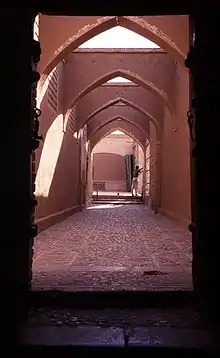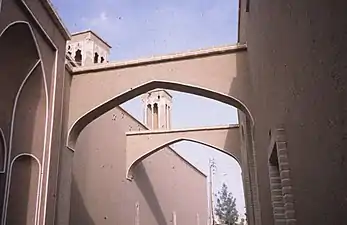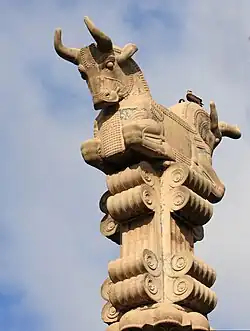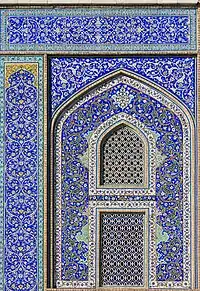
A Kucheh in Kashan. Photo was taken from entrance to Tabatabaei House looking outside into the Kucheh.
In traditional Persian architecture, a kucheh or koocheh (Persian: کوچه), is a narrow especially designed alley.[1] Remnants of it are still seen in modern Iran and regional countries.
Before modernization, Persia's old city fabric was composed of these narrow winding streets, often made with high walls of adobe and brick, and often roofed at intervals. This form of urban design, which was commonplace in Persia, is an optimal form of desert architecture that minimizes desert expansion and the effects of dust storms. It also maximizes daytime shading, and insulates the “fabric” from severe winter temperatures.
 An example of how Kuchehs were roofed. Sometimes, such as in Isfahan, the kucheh was roofed for much of its span. This example is in Nain.
An example of how Kuchehs were roofed. Sometimes, such as in Isfahan, the kucheh was roofed for much of its span. This example is in Nain. A Kuche-Bagh (Kucheh + garden) in Najaf abad.
A Kuche-Bagh (Kucheh + garden) in Najaf abad. The high walls of the Koocheh provided relief from dust storms and intense sunlight. This was an efficient and ancient form of urban design in Persia.
The high walls of the Koocheh provided relief from dust storms and intense sunlight. This was an efficient and ancient form of urban design in Persia. A Kucheh in Yazd
A Kucheh in Yazd
References
- ↑ Fallāḥʹfar, Saʻīd (سعید فلاحفر). The Dictionary of Iranian Traditional Architectural Terms (Farhang-i vāzhahʹhā-yi miʻmārī-i sunnatī-i Īrān فرهنگ واژههای معماری سنتی ایران). Kamyab Publications (انتشارات کامیاب). Kāvushʹpardāz. 2000, 2010. Tehran. ISBN 978-964-2665-60-0 US Library of Congress LCCN Permalink: http://lccn.loc.gov/2010342544 pp.182
Wikimedia Commons has media related to Kucheh.
Wikimedia Commons has media related to Walkways in Iran.
This article is issued from Wikipedia. The text is licensed under Creative Commons - Attribution - Sharealike. Additional terms may apply for the media files.

